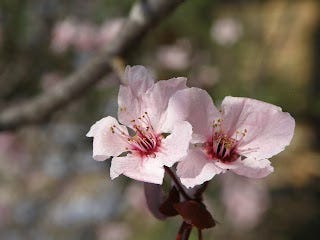Practicing Mindfulness
I sit in our backyard swing one evening in early spring and drink in the sights, the sounds, the fragrances, the textures, of the world around me…
Daffodils splashing dollops of sunshine on the still winter brown grass…a plum tree in full flower… branches of hardwoods, bare yet pregnant with new leaves…robins and cardinals intent on nest building. Tiny frogs with big voices in full chorus...the occasional deep note of a bull frog…the gurgle of water over rocks in the water garden. All this, in our quite ordinary back yard.
What am I am doing?
Reveling in nature’s annual rebirth – and practicing mindfulness. The dictionary definition of mindfulness is simply “active attention.” In practice mindfulness means taking notice of the world around and within us. It means being deliberately aware of our surroundings, of our interactions with others, of our thoughts and feelings, of what is going on in our bodies. It means living consciously in the present moment rather than on autopilot.
Our five senses– taste, touch, sight, hearing, smell – are the doors to mindfulness. Dan Siegel, prolific author on all things mindful, identifies three additional senses: awareness of internal bodily states; awareness of interpersonal relationships; and awareness of mental activities including thoughts, emotions and memories.
Mindfulness does not come easily in our wired, multitasking world. While young children naturally live in the moment and some personality types tend to be observant, for most of us it requires stopping, taking a breath, listening, tuning in. It may mean choosing to do one thing at a time rather than multitasking. This is simple, but not easy. And in a life filled with relentless demands, may seem counterproductive.
So – why bother?
For starters, being fully present in a given moment enriches your existence. Fully experiencing your life adds meaning to everything from daily routines to the best and worst the day brings.
Mindfulness also enhances relationships. Focusing on what your spouse, child, friend or coworker is saying, noticing body language, and tone of voice and facial expression, improves communication and creates connection.
If you struggle with sadness or worry, recognizing your own negative thought patterns opens the door to changing the way you think, and thus the way you feel.
For many, mindfulness – with roots in the ancient practice of meditation – is apassageway to serenity. And nature is often a pathway to mindfulness.
Diane Ackerman says it well in her book One Hundred Names for Love (2011, W. W. Norton & Co.) “There is a way of beholding nature which is a form of prayer, a way of minding something with such clarity and aliveness that the rest of the world recedes….”
Perhaps the Biblical King David had a similar experience when he wrote, “When I consider the heavens the work of thy fingers, the moon and the stars which thou hast ordained, what is man…” (Psalm 8:3 KJV).
You can start your own practice of mindfulness by something as simple as taking a walk around the block or lingering in your yard and noticing the sights, sounds and smells.
Today my yard is sheltered by a canopy of green, redolent with honeysuckle and alive with the constant thrum of cicadas.
What’s happening in your back yard?

